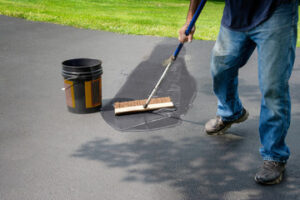Pests cause damage to crops, property, and plants. Some pests also transmit diseases to humans and pets, like plague, hantavirus pulmonary syndrome, Salmonellosis and leptospirosis.

Clutter provides hiding places and breeding grounds for pests. Regularly clean out closets and storage areas to help prevent pest infestations. For professional help, contact Pest Control O’Fallon MO.
If you’re tired of fighting a losing battle against pests in your home or business, it might be time to invest in preventative pest control. A regular schedule of inspections by a professional can help you avoid a pest problem before it starts, and is far less costly than battling a full-blown infestation that can leave your property damaged, and your living or working space uninhabitable.
Preventative measures include removing sources of food, water and shelter for pests. This can be as simple as keeping the exterior of your home or business clean, storing food in tightly sealed containers and putting garbage in covered trash cans that are regularly emptied. Other things you can do include repairing leaky plumbing, keeping the interior of your building clean, and removing clutter that provides pests with hiding places and food sources.
Another way to keep pests away is by using traps or other mechanical controls. These can be as simple as a strategically placed pheromone or scented trap, or more complex systems that include screens and barriers. In some cases, heat, radiation or electricity can also be used to control certain pests.
Chemical pest control is often the last resort when other methods have failed. In many instances, it is a necessary step to ensure the safety of staff and visitors, or to protect the integrity of a building and its contents. Common chemical pest control methods include ultra-low volume (ULV) fogging, which disperses small amounts of insecticide throughout a building, and fumigation, in which the building is sealed and filled with an extremely high concentration of pesticide.
For indoor spaces, pest prevention can be especially challenging, as there are generally more factors at play than in outdoor areas. Museums and other indoor spaces, however, can be adapted to prevent pests through increased sanitation, adjusting shelving and cabinet layouts to allow clear lines of sight for inspection, reducing the amount of material that is stored in the building, creating sanitary perimeters around rooms and floors through organized storage practices, and installing appropriate intrusion alarms.
There are many other ways to promote good pest prevention, but it often takes a trained eye to spot potential issues before they become an infestation. Regular inspections by an experienced pest control professional can help you stay ahead of the curve and save yourself from a costly pest invasion.
Suppression
Pests can be a nuisance for both commercial and residential premises. They contaminate food and water supplies, damage building structures and spread disease to animals and humans. They also interfere with production and processing operations, cause physical contamination by rodent droppings, fecal matter or other material or by transmitting diseases through their saliva, causing health problems like asthma attacks and skin allergies. The infestation of pests can also reduce the value of property or cause damage to equipment and stock.
Pest control involves a number of tactics, both chemical and natural. The choice of which to employ depends on the situation and the desired outcome. Natural controls include using the habitat of pests to their disadvantage. These methods can be used in addition to or instead of other pest control measures.
Some natural forces influence the population of all organisms, whether they are considered to be pests or not. These can include climate, natural enemies, natural barriers and available food and water sources. It is important to understand these factors and take advantage of them. This includes scouting (regularly searching for and assessing pest populations) and monitoring the presence of parasites and predators in the vicinity of pests.
Temperature control can be used to kill a variety of pests at certain temperatures. This is often combined with cultural controls, such as plowing or crop rotation to deprive pests of their comfortable habitat and to prevent their spread. Cultural controls also include avoiding wet, high humidity conditions that encourage disease pests.
Biological controls are natural predators or parasites that can be conserved or released to reduce the number of pests. These can include beneficial mites that feed on the harmful mite pests in orchards, nematodes that kill harmful soil grubs and wasps that parasitize greenhouse whiteflies. Biological control can be very effective, particularly in confined spaces.
Pheromones can be used to attract and capture pests, as well as to confuse males and prevent mating. Juvenile hormones can also be used to keep immature pests from changing into normal adult forms, reducing their numbers.
Eradication
The goal of eradication is to destroy a pest population to the point where it can no longer impact agriculture, human health or the environment. This is a difficult task as most pests have natural enemies that help control them, and these organisms may be resistant to certain types of pesticides. Additionally, a lack of resources or political problems can hamper an eradication effort.
Eradication differs from suppression in that it requires a worldwide effort to prevent the re-establishment of a pest, whereas merely controlling it limits its spread within a defined region. The success of a disease eradication program is based on the availability of effective intervention tools that can be used on a global scale. To date, only two diseases have been officially eradicated: smallpox and rinderpest (caused by the variola and rhamphoviruses respectively). These diseases were once common throughout the world and caused large-scale epidemics that killed millions of people, but vaccines and a focused global campaign were successful in eliminating them.
The most important aspect of eradication is accurate pest identification. This will allow the selection of the most suitable insecticide and application method. In addition, proper pesticide application can minimize the effects on natural enemies. This is achieved by using less persistent pesticides and applying them with knowledge of the life cycle of the pest in order to avoid spraying its vulnerable life stages. Also, spot applications or the treatment of alternating strips within a field can leave some areas untreated and reduce exposure to pesticides for natural enemies in those areas.
Biological pest control uses the natural abilities of the ecosystem to control the pest, such as predation, parasitism or herbivory. However, it typically requires an active management role, mainly through the introduction of additional natural enemies to augment the native population. These can be bred in the laboratory and then released into the environment, or they can be collected from the wild and introduced in small batches.
The effectiveness of biological controls depends on the health and abundance of the indigenous population, as well as the quality of the pesticides selected to introduce. They can also be affected by climatic factors, such as rainfall or temperature. The ability of a biological agent to colonize the pest habitat can also be reduced by the presence of competing species, or by cultural practices such as land clearing.
Monitoring
Monitoring is the process of checking a field, landscape, forest or building to determine whether pests are present and how many there are. This information is used to decide whether a pest needs control and, if so, which management method will be most effective. Monitoring also helps you evaluate your control methods to ensure they are working properly.
In integrated pest management (IPM) programs, monitoring is an essential part of the decision-making process that guides all other aspects of the program. It involves regular inspections of fields, often called scouting, to search for and identify pests, disease organisms, nematodes and weeds. The frequency of these inspections depends on the crop type, stage and pest species, but should be scheduled so that increases in pest populations can be detected before economic thresholds are reached.
Accurate pest identification is the first step in effective IPM. The ability to distinguish different pests from similar-looking organisms is a critical skill for accurate and cost-effective pest control. It is also important to know when a pest population is reaching an action threshold, the point at which it should be controlled, because IPM programs always try to minimize pesticide use and maximize beneficial and non-target organisms.
Observation of pests in the field can be done using a variety of observational techniques, including visual inspection, sticky traps and pheromone lures. A phenology calendar, which correlates periodic biological events like plant growth with seasonal climate changes, is another useful tool for tracking the progress of pests through their life cycle. This is particularly useful for determining the timing of IPM control strategies that are dependent on synchronizing insect development with natural environmental cycles.
If monitoring, identification and action thresholds indicate that a pest infestation is likely to occur or has already passed a certain level, IPM programs first consider less risky, preventive controls, such as habitat manipulation and modification of cultural practices, before turning to chemical treatments. If these fail, more aggressive pest control methods may be employed, such as targeted spraying of highly specific pesticides. This approach allows the most beneficial and non-target organisms to remain unaffected, while minimizing risks to human health and the environment.








